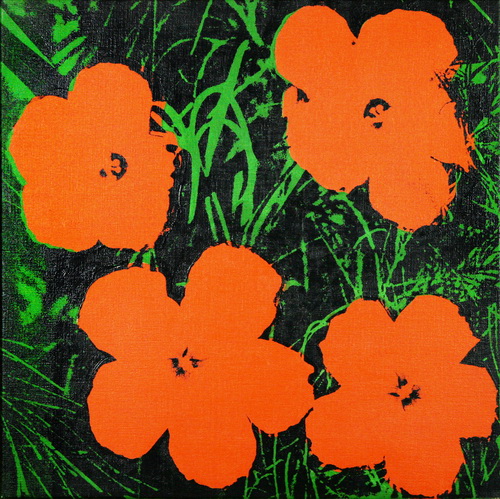Acquisition Number: 72.31.A
Medium:
Silkscreen on canvas
Size:
24 x 24 in.
Date:
1964
Credit: Aline Rhonie Fund thru American Federation of Arts
"Flowers" marks Warhol's departure from everyday objects and celebrities, which took his work in a new direction and surprised the art world. "Flowers" was first exhibited in the Leo Castelli gallery in New York in 1964. Warhol used a photograph of hibiscus blossoms he found in the 1964 issue of Modern Photography to create these prints, and found himself in his first lawsuit over the usage.
Between June and September of 1964, Warhol's studio – the Factory – was a production line for "Flower" paintings of different sizes. Throughout this phase of his artistic development, Warhol pioneered and refined the screenprinting process that he had made his own. The production underwent three phases: firstly, the forms of the flowers were stenciled and colored paints were applied by hand onto the primed canvas; once dry, the flowers were masked and the green acrylic of the surrounding ground was applied with a wide brush; finally, the screenprint image was applied over the dried image. Over the course of painting this series of images, Warhol's choice of paints would also include the more fluorescent Day-glo colors. Ten days prior to the Castelli exhibition, Warhol delivered 45 "Flower" paintings in the 24-inch format to the gallery, from which 28 were hung in the show in four rows of seven, from floor to ceiling.
Warhol's interest in nature was lifelong. As a child he drew animals in science class at Holmes School, kept a flower garden in the family’s yard, and drew in Schenley Park and Phipps Conservatory. In college, he went to the zoo in Highland Park to draw. Later in life Warhol created his Cow and Fish Wallpaper, the film Sunset, and hundreds of paintings, prints, and drawings of flowers. Warhol created more than 10,000 images of flowers over the course of his career. Warhol even owned beachfront property on Long Island, which is now The Andy Warhol Preserve, a gift to The Nature Conservancy from The Andy Warhol Foundation for the Visual Arts.
|
